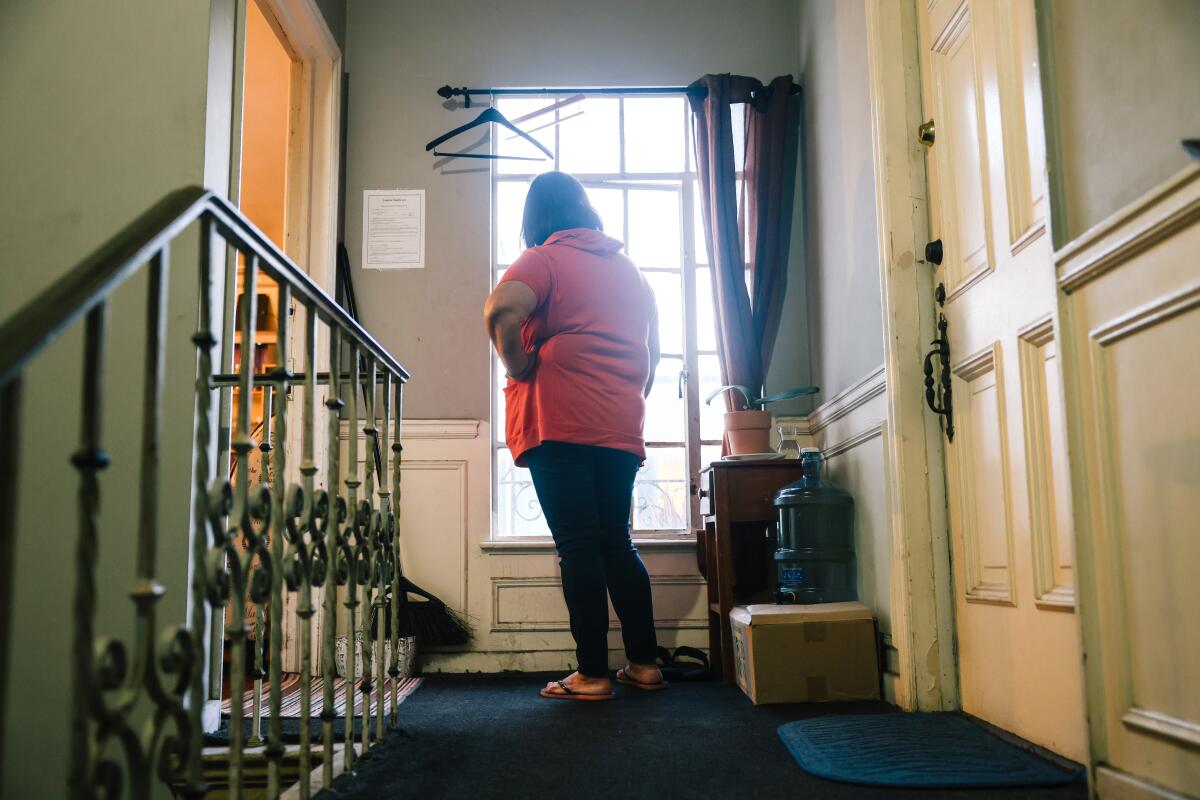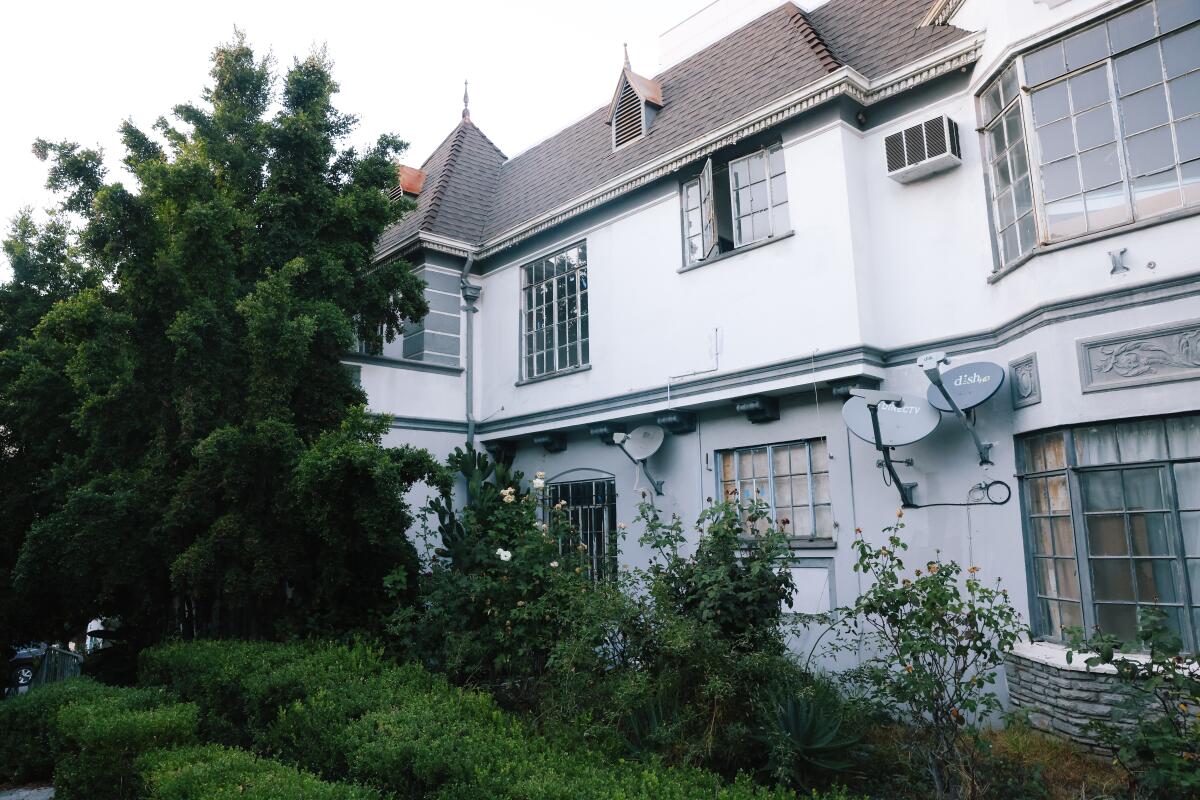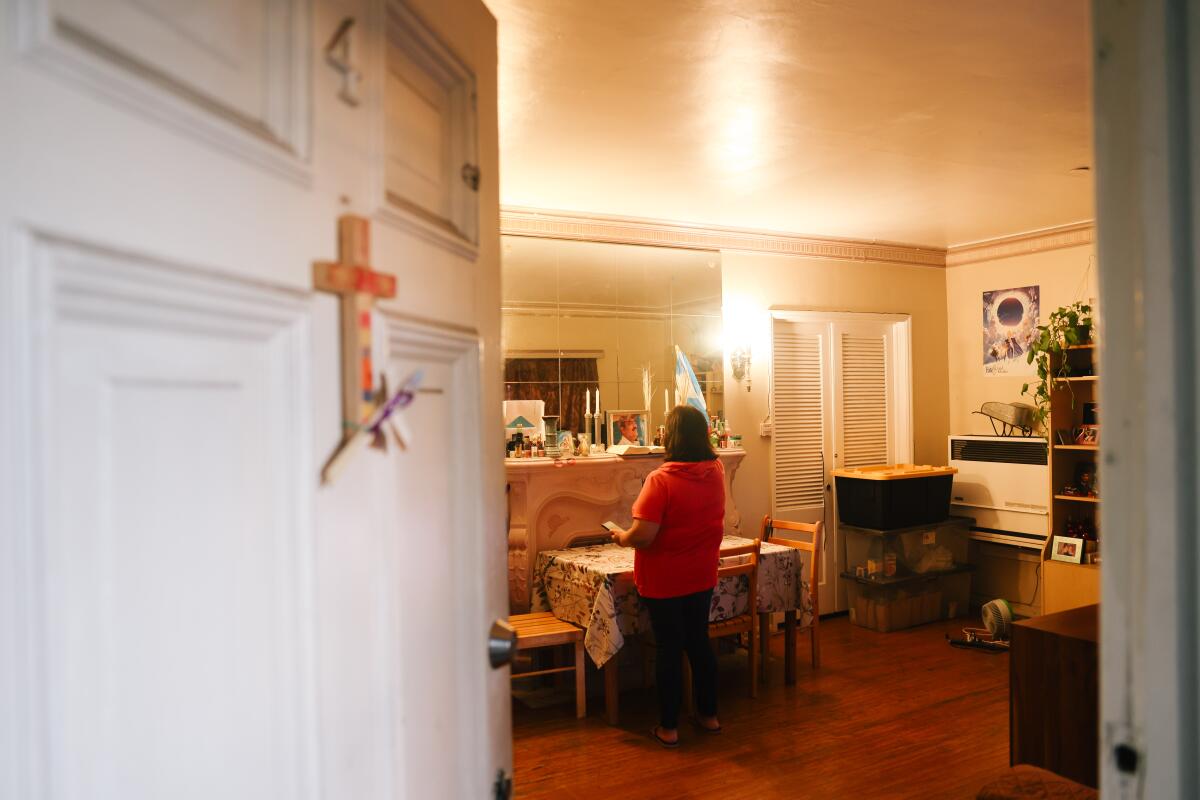They fought an Ellis Act eviction and won. Now they’re the only ones left in a historic building

- Share via
Jovita Cuevas comes home every day to her 83-year-old Koreatown apartment building, greeted by the signs of abandonment. She passes overgrown rose bushes lining the driveway, boarded-up bay windows on the first floor, No Trespassing signs and a notice, dated 2017, that the complex is set to be demolished.
On the second floor, she walks down a dark hallway to the door with a sliver of light through a crack in the upper right corner.
This is where Cuevas, 64, and her son Leonardo, 25, live as the last remaining residents of a historic, rent-stabilized building following years of fighting against the owners’ plan to build a more lucrative residential tower in its place.
One by one, the residents of Cuevas’ six-unit building reached settlements and left. But Cuevas and her son are determined to hold on to the spacious one-bedroom with wood floors where Leonardo has lived his entire life and where they pay $975 a month in rent, an amount that’s impossible to match nearby.

The Cuevases won a rare victory in court earlier this year, when a jury found that the owner failed to prove that it was acting in good faith when it tried to evict them under the Ellis Act, which allows landlords to evict residents of rent-stabilized buildings if they intend to raze the building or go out of the rental business.
Across Los Angeles, the Ellis Act has led to more than 29,000 rent-controlled units being taken off the market since 2001, according to the Coalition for Economic Survival which collaborates with the Anti-Eviction Mapping Project, a group that examines data on evictions.
But months after the win, Cuevas and her son are still uncertain about their future in a building that remains abandoned except for them. Cuevas vacuums the shared hallway and sprays deodorizer to cover the musty smells from the other units. On occasion she pays a gardener to trim the overgrown hedges outside.
“What are they going to do with us?” Cuevas asks.
“We don’t know,” her son responds.

The biggest weapon in their fight to stay has been the history of the building.
About a century ago, there was a single-family house on the knoll where Cuevas’ apartment now stands. When the city emerged from the Great Depression, investors began replacing the homes in the neighborhood with small apartment complexes.
In 1940, Los Angeles Times advertising executive Leo Altman joined in on that investment boom — moving the house on the property so that he could build the French Normandy-style apartment building that’s there now, which was designed by Edith Mortensen Northman, one of the few prominent female architects in Los Angeles at the time. Altman lived with his wife in one of the units and rented out the others for extra income until he died at home in 1952. After his death, the property changed hands several times over the years as the neighborhood transformed into a bustling immigrant community.
Cuevas arrived in Koreatown in the ’90s from Chiquimula, Guatemala, after a stint in Bakersfield. She lived in the complex next door for a couple years until, in 1996, the landlord offered her the chance to move to the apartment where she now lives.
She was delighted for the opportunity — at about 1,000 square feet the apartment was spacious and pretty, with detailed crown molding, pale-green tiles in the bathroom and a pastel pink faux fireplace.

At the time, she paid $600 a month, money she earned as a nanny caring for the children of well-off families in other neighborhoods across the city. Her son was born a couple of years later.
Over the years, the building continued to change ownership. While it didn’t affect Cuevas much, she increasingly noticed old complexes across the neighborhood being razed so that bigger, more expensive ones could take their place. In 2016, the wave of change arrived at her doorstep when developer Bruce Arefi bought her building along with the one next door, with plans to demolish both and build new towers.
In the adjacent building, the plan worked. Arefi’s company has built a six-story, 61-unit tower that bills itself as “a slice of paradise in the bustling city.” A 576-square-foot studio there rents for about $2,600 a month.
The plan also seemed to be on track in Cuevas’ building as each of her neighbors accepted buyout offers to leave starting in late 2017.
But for Cuevas, a single mother whose son was in college at Cal State Northridge at the time, the nearly $11,000 they would have gotten for relocation didn’t feel like enough to continue living in Los Angeles.

She was determined to keep the home at least until her son could graduate. When she was served with an Ellis Act eviction notice in 2019 she sought the help of the LA Tenants Union and she eventually found attorney Sean Chandra, who agreed to take her case. At the time, Chandra, who uses they/them pronouns, worked for the nonprofit law firm Eviction Defense Network, though Chandra would later take the case to the firm Public Counsel when they changed jobs during the pandemic.
The Ellis Act was enacted in 1986, following a state Supreme Court ruling that rejected the argument that landlords had a constitutional right to evict tenants and go out of the rental business.
Many owners see the law as a vital protection, giving them the ability to go out of the business of being landlords. But advocates say it has acted more like a loophole, giving developers the ability to evict residents from rent-stabilized units and build more expensive units that are often returned to the rental market with little consequence.

After taking the case, Chandra learned that because of its unique architecture and its ties to a prominent female architect, the building had been declared a historic-cultural monument by the city in 2016, just as Arefi was buying the property. The designation meant that the owners would not be able to simply demolish the property — any effort to do so would be strictly regulated by the city and could have difficulty succeeding.
That left the owners with more limited options for developing a new building on the property — including possibly trying to move the aging 7,100-square-foot building.
Ellis Act rules in Los Angeles require landlords to act in “good faith” when they invoke the law. For Cuevas and her son, any chance of blocking the eviction would mean asking a jury to decide whether the owners were genuinely intending in good faith to take the unit permanently off the rental market.
Three months after the end of pandemic-era eviction protections, the owner of Barrington Plaza has initiated one of the largest mass evictions in L.A. in recent years.
The case was set to go to trial in March 2020, just as the pandemic shut everything down. Two years later, as the case continued winding its way through the court system, the developer’s then-attorney was interviewed about Cuevas’ case by the news outlet CalMatters for a story examining a legislative effort to curb Ellis Act evictions. He seemed to articulate the profit motive that many advocates fear is actually behind evictions under that law.
“You tear down an old building, you want to build something that’s going to maximize your income,” attorney John Greenwood told the outlet. “So it’s hard to incentivize building low-income property. And these Ellis Act evictions do displace poorer people, that’s understood. But, you know, that’s also the definition of progress — making things better.”
In August, the case finally made its way to trial. Over two days in a courtroom at the Stanley Mosk Courthouse downtown, Arefi and his son testified about their plans for the building.
Subscribers get early access to this story
We’re offering L.A. Times subscribers first access to our best journalism. Thank you for your support.
They talked about potentially moving it, though they were uncertain about whether they would actually do so.
They said that they had recently learned that city rules might actually allow them to demolish the building after all and that they were considering developing affordable housing under incentives offered by Mayor Karen Bass, though when pressed they struggled to point to exactly how.
Joseph Kellener, who represented the Arefis in court, said his clients asked him not to comment for this story.
Once the testimony and the closing arguments were over, the jury was tasked with answering a list of questions, the last one being the critical one: Did the owner prove that it seeks in good faith to recover possession of the rental unit?
The answer was no. Cuevas, who had been clutching her rosary in her pocket, didn’t understand what was going on at first, until the members of the tenants union who were in the courthouse to support her erupted in cheers.
After they celebrated, Cuevas and her son returned to their home, thrilled for what they saw not just as a victory for them but as a glimmer of hope for tenants across the city confronting Ellis Act evictions. But the building she fought for isn’t the same as it once was.
A few weeks ago, an L.A. County Department of Public Health inspection found raw sewage accumulating in the bathtub, shower and floor of one of the downstairs units. There are overgrown trees and bushes in front where passersby frequently drop their trash.
“If they’re not taking care of their own apartments, it’s got to be for a reason,” Cuevas said.
Looking around at her living room, with its paintings of colorful quetzal birds on the wall and the photo of her brother, who died during the pandemic, on the mantel, she said that whatever happened she was proud of what she had achieved. When the eviction notice arrived, her biggest goal had been to stay until her son graduated from college. He did that earlier this year.
“We’ve managed to live here a long time,” she said. “Now it’s in God’s hands.”
More to Read
Sign up for This Evening's Big Stories
Catch up on the day with the 7 biggest L.A. Times stories in your inbox every weekday evening.
You may occasionally receive promotional content from the Los Angeles Times.















